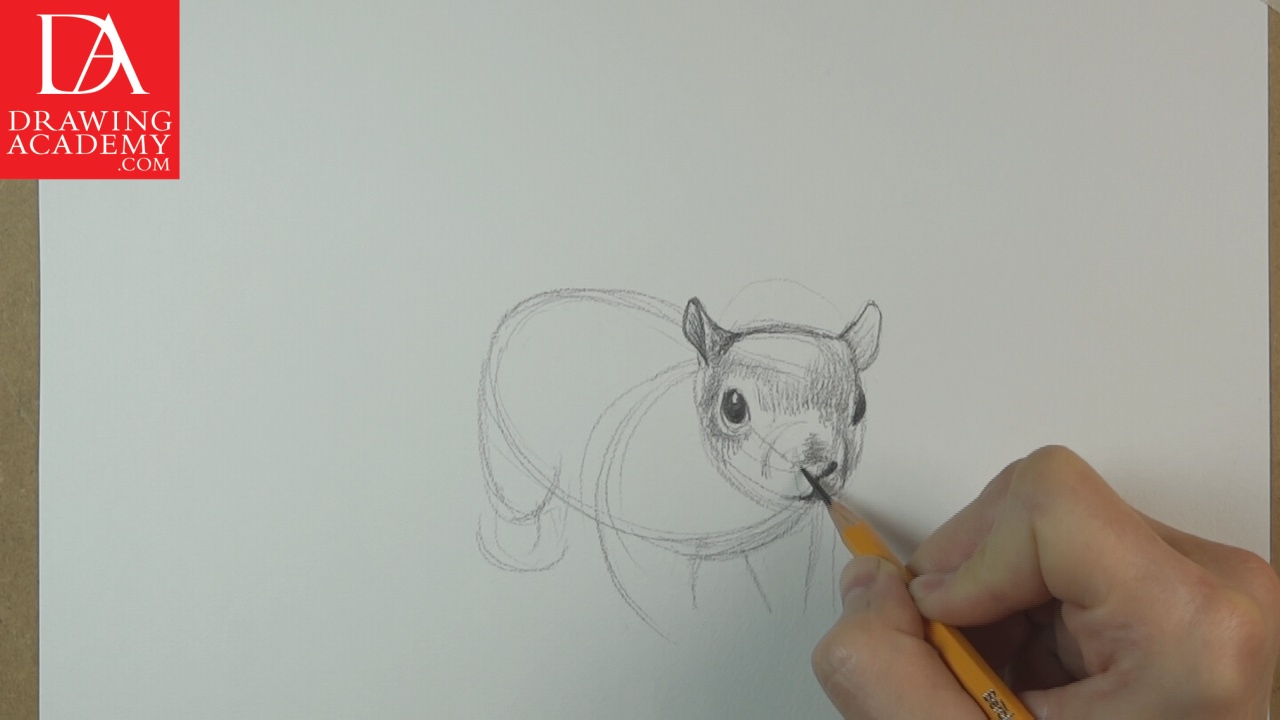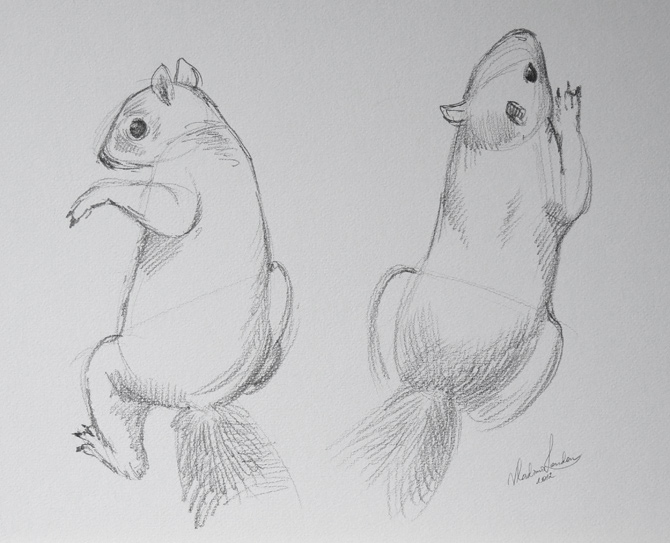Discover How to Draw Animals
In this “How to Draw Animals” video lesson, we will do three quick sketches of a small animal, squirrel in various poses.
Enroll in the Drawing Academy Course
Pay once - Enjoy forever!
Only $297
How to Draw Animals – Squirrels
When it comes to a topic of “How to Draw Animals” and making quick sketches of animals, soft grade 2B or 4B pencil is good for this task. We begin the “How to Draw Animals” video lesson with the peanut-like shape that for now represents the squirrel’s body. The animal is facing us on the drawing. Its front limbs and shoulders are marked in a half-oval shape that resembles a horseshoe.

In very first steps of this “How to Draw Animals” lesson the squirrel’s head is depicted as a rounded shape above its shoulders. This oval has its more pointed end toward the squirrel’s nose. The head will take more precise shape later. All lines are very approximate at this stage. I am more interested in the overall proportions of the animal.
When considering ‘how to draw animals’ fur and drawing a tail, do not attempt to depict individual hairs. Instead, think what the tail’s shape is, how it is bent and positioned. Think of it as a big three-dimensional mass that has its own volume and shape. Rendering the tail’s texture comes later. Longer pencil strokes can be used for that purpose. Go with a pencil along the direction of the hair. Make this object appear three-dimensional by analyzing and depicting where the light comes from and what areas of the tail are well lit and what areas are shaded. The tail in our sketch is very much foreshortened. It is not the easiest point of view to top draw and that is what makes it even more interesting to practice.

When the overall proportions of the animal are sketched out in this “how to draw animals” video part, it is time to depict smaller details and characteristic features.
The squirrel’s big eye is rendered in high contrast between the reflected spot of light and the dark surface of the glossy eyeball.
The short nap of the squirrel’s head is done in a few short pencil strokes. This “how to draw animals” video features a fast sketch, so I will not dedicate too much time to texture rendering.
The point of this exercise is to portray a squirrel in movement using a few laconic lines rather than depicting nuances of tonal shading.
Just some rendering of the squirrel’s fur and shaded areas will suffice for this sketch. I draw just a bit of the fur texture, concentrating more on the animal’s pose. This is another quick sketch that is not intended to be finished in tonal rendering.
The grey squirrel’s ears are quite big in proportion to its head. This animal has a very good sense of hearing. Its ears have an interesting curved shape.
Big dark eyes are located on the sides of the head and closer to the head’s topside. It gives it a wide field of view, which is very useful to see predators coming at it from any direction. Squirrels have binocular vision that is required to judge distances and move with precision.
The light is reflected from the glossy surface of its dark eye, forming a highlighted spot. The high contrast between this highlighted spot and the dark eye surface makes the glossy texture of its eye more realistic on the drawing.
Gray squirrels have lighter rings of fur around their eyes. The fur on the squirrel’s head is much shorter than on its body. I am drawing it with short strokes of the pencil. Longer strokes of the free-hand hatching are applied for drawing the squirrel’s shoulders.
On the head, squirrels have four sets of sensitive whiskers, also called vibrissae. The long vibrissae or whiskers are located alongside the squirrel’s nose. These vibrissae are touch sensitive and act as receptors. Squirrels feel their immediate surroundings through these vibrissae.
A squirrel’s toes end in claws. These curved, pointed nails are quite sharp and strong. A squirrel’s front limbs are well suited for grasping and holding food. Strong limbs make squirrels excellent climbers and diggers.
Squirrels have short forelegs and longer hind legs. However, in our drawing, the hind legs are foreshortened, which makes them appear shorter. Squirrels have flexible ankle joints. This type of limb anatomy enables the hind feet to rotate backward. This comes in very handy when a squirrel dangles from its hind feet or descends a tree trunk head-first.
The bushy tail is the signature feature of the squirrel. The tail has well-developed muscles that can move in all directions. A squirrel’s tail serves multiple functions, however, it is not critical to the animal’s survival. If a squirrel looses its tail to a predator, the animal will survive. Would it have the same quality of life? Probably not, as it uses its tail for a multitude of its daily activities. A squirrel’s tail serves to help it keep balanced when it runs and leaps. Also it provides good heat insulation during cold weather and acts as an umbrella, providing shade during heat waves. It is also used for communicating with other squirrels.
When it comes to the topic of “how to draw animals”, keep in mind that making just one or two sketches of an animal is not enough. To improve your animal drawing skills, I would suggest making dozens and dozens of sketches in different poses and from different points of view. Thus, you will train your hand and eyes, making your drawing effortless.
Making rapid sketches of animals is a great way to practice drawing from nature. When considering ‘how to draw animals’ and improve your art skills, drawing multiple short pictures will give you more skills than spending the same amount of time on a single highly polished picture.




